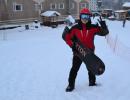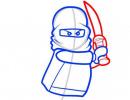Departments of the human spine table
The spine is the basis of the human skeleton, its pillar and core. The anatomy or structure of the human spine is so unique and multifunctional that it allows you to simultaneously be rigid, holding the weight of the human body, and also be flexible, providing mobility for the whole body. The spinal column is the frame of the human body, nature conceived it strong, strong, but mobile.
The spinal column consists of a series of vertebrae - 34 pieces, interconnected by intervertebral discs, ligaments, joints, muscles. The coordinated work of all elements, the unique anatomy of the spinal column ensures its normal functioning, as well as comfortable human movements.
The spine consists of more than 200 bones, joints, ligaments of various sizes. Five sections of the spine, which form four curves that form an S-shape, provide the body with maximum mobility and shock-absorbing softness. The anatomy and structure of the spine is designed in such a way as to protect it from shock, injury or damage.
- 2 Vertebrae and intervertebral discs
- 2.1 Structural features of intervertebral discs
- 3 Nervous system and spinal cord
- 4 Functions of the spine
Departments of the spine
The main column of the musculoskeletal system consists of five main sections: cervical, thoracic, lumbar, sacral, coccygeal. Their structure is similar to each other, although there are certain differences. Interestingly, the vertebrae of the first three sections are called true, and the vertebrae of the two lower sections are considered false. All departments and vertebrae have Latin names, for convenience they are indicated by a Latin letter and a number. Such a classification of the spinal column was invented by medical scientists in order to easily understand which part of the column we are talking about.
Main mobile departments
The cervical spine has a curved back, it consists of seven vertebrae. This vertebral section is the most mobile part of the spinal column, because the vertebrae of the cervical section provide not only head tilts forward or backward, but also turns in different directions. The first vertebra of the cervical region differs in its shape and structure, it is called Atlas. The second axial vertebra is called the axis.
The thoracic section of the ridge has an inward bend and consists of 12 vertebrae. All vertebrae of the column have transverse processes, and in the region of the thoracic region, ribs are attached to these processes.
The intervertebral discs of the thoracic region have the smallest height compared to the discs, for example, of the cervical region, therefore this part of the spine is the most inactive and static.
The lumbar region includes the five largest vertebrae, it has a much greater load than the tension of the cervical region. This part of the spinal column has a forward bend. Being between the inactive thoracic region and the completely immobile sacral region, the lower back experiences serious stress, especially when a person lifts weights or plays sports.

Lower spine
The sacral and coccygeal sections consist of fused vertebrae, five each, they represent an almost monolithic part of the spine. Despite the fact that these two areas bear the greatest weight of a person's weight, the sections, due to their fused structure and shape, do an excellent job of being the basis of the spine.
The scheme of all sections of the spine and other components resembles a snake, which bends in some places, has the thinnest part in the cervical region. The bends have Latin names: kyphosis and lordosis, and the spine itself has the Latin name columna vertebralis.
Vertebrae and intervertebral discs
Despite the fact that the structure and appearance of all vertebrae are almost the same, they have different sizes. The size of the vertebrae increases from top to bottom, and sharply decreases in the region of the cervical region. Each vertebra is a ring with a hole inside through which the human spinal cord passes. The processes, arch and pedicle of the vertebra are attached to the ring.
The strength of each vertebra is provided by internal spongy substance and external bone tissue, which protects the spine from impact. The vertebrae of the cervical region are slightly smaller than the rest, they have less developed processes. In the transverse processes of the cervical region there are openings through which the arteries pass. The blood vessels of the spinal column provide blood supply to the back and head.
The thoracic vertebrae join with the costal bones to form the ribcage. But the ribs are not a continuation of the vertebrae, they are interconnected by ligaments and joints. This provides additional mobility to the spine. Individual vertebrae are associated with certain internal organs and parts of the human body, if a violation occurs in one part of the back, this immediately affects the functioning of any other body systems.

Features of the structure of intervertebral discs
Intervertebral discs are located between the vertebrae, make up approximately 20% of the length of the spine and consist of two parts: the annulus fibrosus and the nucleus pulposus. In terms of its composition, the disc is quite soft, elastic, which allows it to distribute the load exerted on the spine.
The height of the intervertebral discs can change, for example, in the morning it is larger, in the evening it decreases under the weight of body weight and loads.
Nervous system and spinal cord
The spinal cord is safely hidden in the bone tissue from damage and external influences. Nerve endings and roots depart from the spinal cord, providing sensitivity and functionality of the spine. It is these nerve currents that provide the vital activity of the human body.
The nervous system transmits impulses from the brain to the muscles. The contraction of the muscles located along the spinal column ensures the mobility of the body. In addition, the nervous system controls the work of all internal organs and ensures their well-coordinated work. That is why in violation of the spine can often spread to internal organs and systems. Therefore, it is important to understand their structure.
Functions of the spine
The spine - as the main pillar of the musculoskeletal system, performs the most important functions for human life and activity. The anatomy of the back frame is due to its structure and the presence of many components, which allows it to perform the following functions:
- support function, which maintains the body in an upright position, allows a person to stand, walk, move in general;
- protective function that ensures the safety of the spine from injury or disruption;
- motor function that provides turns, tilts, bending, twisting;
- cushioning function to soften steps, jumps, falls, etc.
The muscles of the back are largely interconnected with bones, joints, and nerve endings. It is the muscular corset that is responsible for the mobility of the spine. The correct functioning of the spinal column ensures the normal mobility of a person.
The structure of the spine is quite difficult to study, but it is interesting and useful in order to understand what happens to the back if there are movement disorders or pain. A correct understanding of the structure of the column can help to avoid many problems.
vashpozvonochnik.ru
Numbering of human vertebrae - how is it done?
The human spine is made up of vertebrae. They are connected by intervertebral discs, joints and ligaments. The spinal column contains 32 to 34 vertebrae.
Clinicians divide the spine into 4 sections: cervical, thoracic, lumbosacral and coccygeal. Anatomists distinguish 5 sections: cervical, thoracic, lumbar, sacral and coccygeal.
Each department contains a certain number of vertebrae. The name of the human vertebrae is carried out according to the Latin letters with which the name of the departments begins, and the numbers indicating the serial number of the vertebra in the department.
Human vertebrae are numbered from top to bottom.
Sections of the spinal column
The cervical, or cervical, section (vertebra cervicalis) of the human spine always contains 7 vertebrae. They are numbered C1-C7. Conventionally, the occipital bone is referred to as the "zero vertebra" (C0).
The thoracic region (vertebra thoracica) consists of 12 vertebrae connected to the ribs. The name of the human vertebrae included in this department has several alternative options: T1–T12, D1–D12, or Th1–Th12.
In the lumbar region (vertebra lumbalis) there are 5 vertebrae. They are numbered as L1–L5.
In the sacral region (vertebra sacralis) there are also 5 vertebrae, but they fuse together. The numbering of the human vertebrae of this department is designated as S1–S5.
In the coccygeal region (vertebra coccygis), the number of vertebrae can vary from 3 to 5. They are called Co1-Co5. In adults, these vertebrae fuse to form the coccygeal bone.
Unique vertebrae
In the cervical spine there are vertebrae that have a special structure and their own names.
The first cervical vertebra (C1) is often referred to as Atlas or Atlas.
The second vertebra of the neck (C2) is called Axis, Axis or Axial.
The seventh cervical vertebra (C7) is often referred to as Vertebra Prominens, or Speaker.
Special cases
Sometimes the first sacral vertebra (S1) does not fuse with the second (S2), but forms an independent anatomical unit. In this case, it is called the sixth lumbar vertebra (L6). This phenomenon is called lumbalization - an increase in the lumbar region.
The opposite situation is also possible. In this case, the fifth lumbar vertebra (L5) joins the sacrum and is called the first sacral vertebra (S1). This phenomenon is called sacralization - an increase in the sacral region.
Lumbarization and sacralization are very rare, but are considered normal.
spina-info.ru
Human spine: cervical, thoracic, lumbar, sacral, coccygeal
The lumbar region is represented by five vertebrae. The size and structure of the lumbar vertebraeThis department accounts for a significant amount. For this reason, the vertebral bodies here are large. It provides for the following elements:
Lumbarization (sixth vertebra)Some people in this department have six vertebrae. This phenomenon is called lumbarization. Most often it does not imply clinical significance. Normally, this department involves a forward bend and it should be light. The meaning and functions of the lumbarThe significance of this department lies in the fact that with the help of it the following connections are made:
Diseases of the lumbar spineThe upper half of the human body exerts significant pressure on the structures of this department. An additional increase in the applied pressure occurs when a person performs movements consisting in the transfer of a sufficiently large weight, as well as when lifting weights. Such manifestations can lead to wear in this section of the intervertebral discs. If the pressure inside the disc increases very much, this can cause negative consequences:
This is how a disc herniation occurs. It can cause nerve structures to be compressed. As a result, it can be noted that a pain syndrome will appear. Another manifestation in this case is associated with certain neurological disorders. Osteochondrosis of the lumbar spine is the most common type of back disease, since this particular spine is the most mobile. We also recommend that you get acquainted with the causes of back pain above the waist. The sacral spineIn humans, the sacrum is formed by five sacral vertebrae. In children, it consists of individual vertebrae.The structure of the sacrumThe anatomy of this department is characterized by a certain complexity. This is due to the formation of this department due to the fusion of five vertebrae, which is not fully completed. The final formation of the sacrum is completed by the 25th year of a person's life. Functions and tasksThis section acts as a support for the upper sections of the spine. It is the only bone formation that consists of fused vertebrae. In this case, the vertebral bodies are more pronounced, and processes are less pronounced. The trend that is noted in the sacrum is associated with a decrease in power for the vertebrae. This happens in the direction from the first to the fifth. sacralization and lumbilizationIn some cases, there is a fusion of the fifth lumbar vertebra and the sacrum. Sacralization - this is the name of such a manifestation. Lumbilization should be understood as the separation of the first sacral vertebra and the second sacral. Diseases of the lumbarMost often, doctors in patients are diagnosed with such diseases:
Coccygeal spineThis department provides for the presence of 3-5 vertebrae. It is the coccyx that ends the spine. |
|
| "Coccygodynia" is a term that doctors use to refer to pain sensations noted in the coccyx region. | |
In this case, pain can suggest two options:
- sharp;
- chronic.
Of particular danger are situations associated with a fracture or bruise of the coccyx. This results in significant pain. It is equally important that in this case a sufficiently long period of rehabilitation is required. Its duration can be up to one year.
Diseases of the coccygeal spine
The diseases that occur most often include the following:
- pain in the coccyx during pregnancy- this is due to the fact that the weight of the child puts pressure on the back at the bottom. Sometimes during childbirth, trauma to the coccyx occurs when the child passes through the birth canal;
- coccyx fracture- the symptoms of a fracture are sharp pain, the presence of hematomas, tumors, pain in the leg and other manifestations. Recovery after a fracture of the coccyx, as a rule, requires a fairly long time. Statistics indicate that most fractures occur in women. This is due to the fact that they are characterized by a wider structure in the hip bones;
- bruised coccyx- most often the coccyx gets bruised as a result of a fall of a person performed backwards. It can also be trauma that recurs. Severe pain, the appearance of hematomas is the result of bruises and injuries. Most often bruises occur in women;
- pain in the coccyx There are many reasons for the appearance of pain in this department. Based on a specific cause, the pain will have an appropriate character.
Summing up
The vertebrae acts as the main component of the spine. It is a body and an arc that closes the vertebral foramen. The body may be round or kidney-shaped. Additionally, the presence of articular processes is noted.
A characteristic feature of the spine is the presence of curves, which can be seen by looking at it. Such bends are physiological and do not indicate the presence of certain diseases.
These curves are as follows:
- cervical region - arching is noted, which is performed forward. Its name is cervical lordosis;
- thoracic region - a bend is noted, which is performed in the backward direction. This contributes to the formation of thoracic kyphosis;
- lumbar - it provides for the presence of the same bend as in the case of the cervical. This contributes to the formation of lumbar lordosis.
The structure of the spine has its own characteristics, which allow, due to these bends, to perform the functions of a shock absorber. This opens up the possibility of mitigating various shocks. It also protects the brain from concussions when different types of movement are performed. For example, this is such an activity as running, walking, jumping. Thanks to the spine, sufficient mobility for a person is achieved.
Thus, the structure of the spine is distinguished by the presence of five departments, each of which has its own characteristics. It is very important that each person pays special attention to the health of his spine. This should be expressed, first of all, in preventive measures aimed at preventing the occurrence of various diseases. In the event of any alarming symptoms, pain, you should immediately seek the help of qualified specialists, that is, the hospital and doctors. You cannot self-medicate.
yourspina.com
In addition, the spine is a reservoir of cerebrospinal fluid, which performs important functions of the central nervous system.. An integral part of the posterior walls of the pelvic, abdominal and thoracic cavities, takes part in protecting the spinal cord and body movement.
The spine is formed with the help of complex individual bones - vertebrae, where their number is equal to from 32 to 34, depending on the individual development of the lower coccygeal region.
Departments of the spine
The structure of the human spine has five sections:
- cervical- consists of seven vertebrae. There is a physiological curve called lordosis, which resembles the letter "C". The convex side is facing forward. It should be emphasized that the cervical region is considered the most mobile area in the spinal column.
This mobility allows you to perform various tilts and turns of the head and neck. In the transverse processes of the vertebrae of the neck there are blood vessels that perform the functions of blood supply to the brain stem, the occipital lobe of the cerebral hemisphere, and also the cerebellum.
- Thoracic- consists of twelve vertebrae. Normally, the shape of the letter “C” is observed, called physiological kyphosis. The convex side is turned back. The ribs are attached to the transverse processes of the spine with the help of joints, which forms the back wall of the chest.
In the anterior section, the ribs are connected into a rigid single frame, creating a chest in a person. Not a large height of the intervertebral discs reduces the mobility of this part of the spine. However, mobility is limited by spinous long processes of the vertebrae, which are located in the form of tiles.
- Lumbar- consists of the five largest vertebrae. Lumbarization is sometimes observed when the lumbar region has six vertebrae, although there is no clinical significance. Normally, it has a smooth, slight forward bend, which is called physiological lordosis. Connecting the inactive thoracic region with the immobile sacrum, the human spine experiences great pressure from the upper half of the torso.
In the case of lifting and carrying heavy objects, the pressure that affects the structure of the lumbar region sometimes increases significantly. Such circumstances are the cause of wear of the intervertebral discs of the lumbar. Increased pressure inside the disc leads to rupture of the wall of the fibrous ring, that is, to the formation of a hernia.
- sacral department- consists of five fused vertebrae forming a triangular shape. Connects the spine to the pelvic bones. The complete formation of the sacral region ends by the age of 25. Nerve roots exiting through certain openings of the sacrum innervate the pelvic organs (rectum and bladder), perineum and lower limbs.
- coccygeal department, is the lower part of the human spine. Consists of three to five rudimentary fused vertebrae. In women, this connection is mobile, to facilitate the procedure for the birth of a baby.
In profile, the human spine according to the scheme, indicates four physiological bends:
- Forward bends - lumbar and cervical lordosis;
- Bends to the back - sacral and thoracic kyphosis.
This S-shape cushions the spinal column, reducing the load on the vertebrae. The scheme of the frontal plane of the spine also has small physiological curves called scoliosis.
The vertebrae of the lumbar, cervical and thoracic spine of a person are called true vertebrae. The coccygeal and sacral vertebrae are called false, as they have grown together into the coccygeal or sacral bone.
The structure of the vertebra
As mentioned earlier, the human spine is made up of vertebrae. The structure of the vertebra consists of a compact external substance (lamellar bone tissue) and a spongy internal substance that creates the appearance of a bone crossbar.
Spongy substance is responsible for the strength of the vertebra. The compact substance provides the ability of the vertebral body to withstand certain loads (walking, squeezing, and so on). In addition to the bone crossbar, the vertebral body contains the bone red marrow, the main function of which is hematopoiesis.
The structure of the bone of the spine in humans is constantly undergoing renewal, where a certain number of cells are responsible for the destruction of old tissue. The second part forms a new fabric.
The renewal process is stimulated by mechanical influences on the spine, and various loads. The stronger the intensity of such reactions, the faster and better the formation of denser tissue occurs.
The structure of the vertebra has the following elements:
- Body;
- arcs;
- Branches.
The arcs are fixed to the posterior fragment of the vertebral body with two legs, which as a result forms the vertebral foramen. A series of holes from the vertebrae creates the spinal canal. The main function of this channel is to protect and preserve the spinal cord.
Vertebral life support consists of processes on the arc, in which there are the following differences:
- Spinous process - departs from the arc backwards;
- Transverse processes - located on each side of the arc;
- Articular processes - two processes are located on the top and bottom of the arc.
The structure of the lateral spine is endowed with a foramen, formed by articular processes, pedicles and bodies of adjacent vertebrae. These holes provide the entrance of arteries, the exit of nerve roots and veins from the spinal canal.
intervertebral disc
The structure of the intervertebral disc is a complex formation. It is located between the vertebrae of a person and resembles a disk in shape.
The structure distinguishes three main parts smoothly passing to each other:
- nucleus pulposus- a jelly-like mass, the main component of which is glycosaminoglycans. The functions of this substance are the ability to give and take water resources, while doubling the volume of the core. Water absorption is carried out in case of load on the spine. A similar effect externally compensates for pressure. Reducing the load on the spine implements the reverse process - it releases water. This ability creates shock-absorbing functions of the intervertebral disc;
- annulus fibrosus, surrounds the nucleus pulposus, consisting of approximately twenty-five annular plates, separated by layers of collagen fibers. From the front and sides it connects to the nearest vertebrae. The functions of the annulus fibrosus keep the nucleus pulposus in the center, and are responsible for a strong connection with the adjacent vertebra, thereby preventing them from shifting;
- Endplates with the presence of a layer of hyaline cartilage cover the structure of the vertebra from below and from above. In an adult, there are no vessels in the intervertebral disc. Nutrition is carried out using the process of diffusion of oxygen and nutrients from the vessels of the vertebral body. The flow of diffusion processes is the task of the hyaline layer.
Muscular system of the spine
The human spine has a structure in the form of a frame of paravertebral muscles of the peritoneum and back. They are attached to the vertebrae and provide their movement. There are deep and superficial spinal muscles.
With the function of the shoulder girdle, as well as in the process of straightening the back, the superficial muscular system takes part:
vashpozvonok.ru
Departments of the spine
cervical spine
The cervical region is formed by 7 vertebrae, which are usually denoted by the Latin letter C (C1-C7). The vertebrae are counted from above. A feature of the cervical spine is its high mobility. The range of motion during flexion-extension is about 95 degrees, and during rotation it reaches 8 degrees.
The two upper cervical vertebrae have a structure different from the rest.
The first (C1, atlas) consists of two arches, connected by means of bone thickenings into a ring. On the lateral parts of the ring are two condylar joints that fasten the cervical region to the occipital bone.
The second cervical vertebra (C2) is called the epistrophy, which means "rotation" in Greek. It has an odontoid process through which it is movably connected to the atlas. This anatomical structure makes rotational movements of the head possible.
The remaining 5 vertebrae have a normal structure. All of them consist of a body, which is a cylindrical thickening, and an arc adjacent to it. Bone processes depart from the arc, to which muscles and ligaments are attached.
In comparison with the vertebrae of other departments, the cervical ones are characterized by a smaller width and a greater height. This is explained by the low load on the upper part of the spine. In an adult, it does not exceed 115 kg. While the pressure on the lower sections reaches 400 kg. At the same time, due to the low mechanical strength, the cervical vertebrae are most susceptible to injury and dislocation.
In a newborn child, the cervical spine is almost straight. At 3 months, when the baby begins to hold his head, the spinal column bends forward. This bulge subsequently persists throughout life and is called "cervical lordosis".
!!!Be sure to watch the video, simply beautifully and colorfully demonstrating the structure and movements of the cervical spine.
Thoracic spine
This is the largest section of the spine, consisting of 12 vertebrae. Its average length in an adult varies from 25 to 30 cm. In old age, due to the thinning of the intervertebral cartilage, the thoracic region becomes 2-3 cm shorter.
The thoracic vertebrae are designated with the letter T (T1-T12) or D (D1-D12). In their structure, they are slightly different from the neck. The vertebral bodies have two articular fossae for articulation with the ribs. The median (spinous) processes extending from the arc are longer and directed downwards in such a way that the upper ones cover the lower ones like a tile.
The bodies of the thoracic vertebrae expand downward, which is explained by a gradual increase in the physiological load on them. So, if the first vertebra (T1) experiences a torso pressure equal to 120 kg, then the lower (T12) is already about 215 kg.
Due to the thinness of the intervertebral discs and connection with the ribs, the thoracic region has very limited mobility. The range of flexion here does not exceed 35º, extension - 50º, and rotation - 20º.
Like the cervical, thoracic spine straight from birth. At about 6 months, when the baby begins to sit up, the middle part of the spinal column bends backward. This bend in medical practice is called "thoracic kyphosis".
Of the pathological conditions in the thoracic region, postural disorders and pinched nerves are most often diagnosed. But hernias are found extremely rarely here, due to the anatomical features of the thoracic vertebrae.
Lumbar spine
The lumbar vertebrae (L) are the largest, as they account for the bulk of the body. The vertebral bodies are especially developed: the width of the lowest reaches 18-20 mm. The spinous processes of the arches, on the contrary, are short and slightly flattened laterally. Thick intervertebral discs contribute to high mobility of the lumbar region. The volume of flexion here reaches 60 degrees, extension - 50 degrees. The vast majority of people have 5 lumbar vertebrae. Some have 6. Such a structure of the human spine is not considered abnormal, but is considered as one of the variants of the norm.
At the age of 9-12 months, when the child learns to walk, the lumbar section bends backward, forming a lumbar lordosis. Due to the high load, the lumbar region is more prone to such disorders as curvature of the spine and herniated discs. During physical work or during prolonged sitting, the pressure on the lumbar vertebrae increases, so the risks of developing pathologies increase several times.
Sacral spine and coccyx
In an adult, 5 sacral vertebrae are fused into a single bone - the sacrum. Participating in the formation of the pelvis, the sacrum performs a supporting function. The shape of the bone resembles a pyramid, the top of which is turned towards the coccyx. Its posterior surface is convex and covered with bony ridges formed as a result of fusion of the vertebral arches. The sexual features of the sacrum attract attention: in women it is wider and less curved. The coccyx is formed from the fusion of 3-5 vertebrae. Moreover, all of them are rudimentary (underdeveloped), inherited by man from his distant "tailed ancestors".
Communication of the spine with individual organs
Connecting with each other, the vertebrae of all departments form a canal in which the spinal cord lies. Through the holes in the arcs, numerous nerve fibers depart from the spinal cord, which control the work of various parts of the body. The slightest displacement of the vertebrae leads to pinching of the nerves and the appearance of pain in the area they serve.
To understand more precisely the principle of work and the full relationship, read an article with beautiful illustrations about the structure of the human spine.
What exactly caused the violations, only a specialist can determine. An examination by a doctor must be supplemented with instrumental methods of examination: X-ray, CT and MRI of the spine.
osteo911.ru







